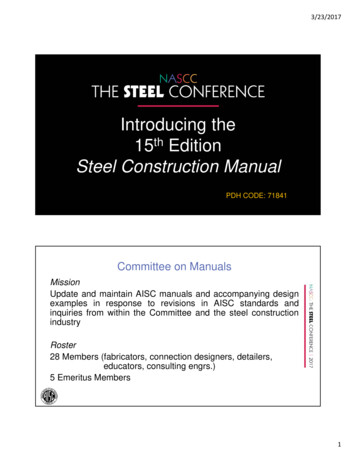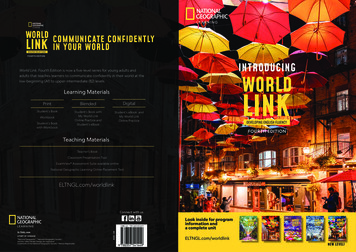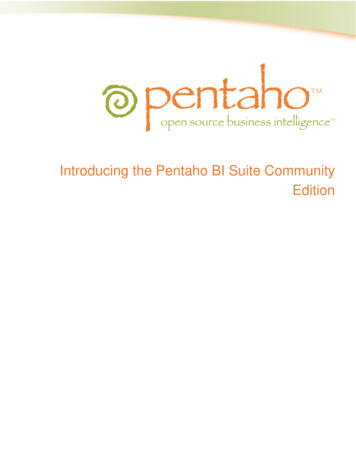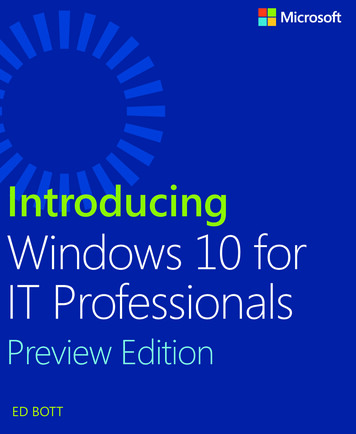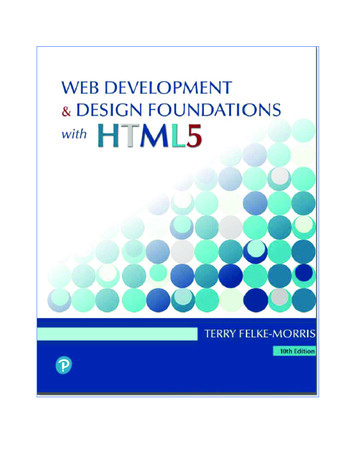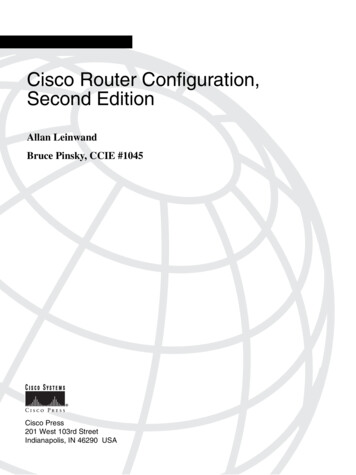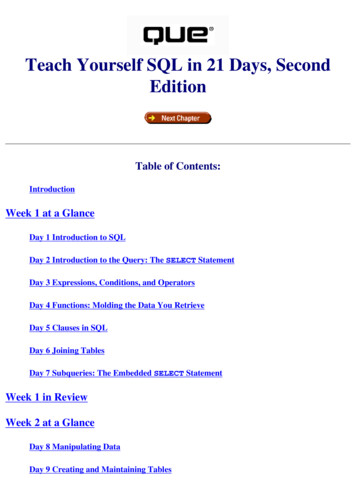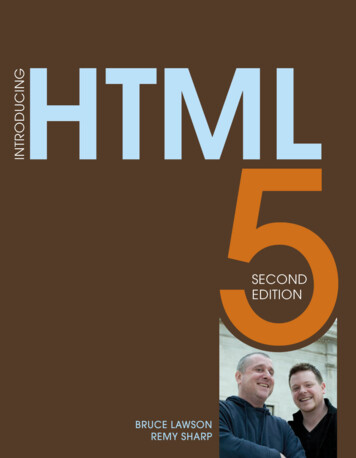
Transcription
INTRODUCINGHTML5SECONDEDITIONBRUCE LAWSONREMY SHARP
Introducing HTML5, Second EditionBruce Lawson and Remy SharpNew Riders1249 Eighth StreetBerkeley, CA 94710510/524-2178510/524-2221 (fax)Find us on the Web at: www.newriders.comTo report errors, please send a note to errata@peachpit.comNew Riders is an imprint of Peachpit, a division of Pearson EducationCopyright 2012 by Remy Sharp and Bruce LawsonProject Editor: Michael J. NolanDevelopment Editor: Margaret S. Anderson/StellarvisionsTechnical Editors: Patrick H. Lauke (www.splintered.co.uk),Robert Nyman (www.robertnyman.com)Production Editor: Cory BormanCopyeditor: Gretchen DykstraProofreader: Jan SeymourIndexer: Joy Dean LeeCompositor: Danielle FosterCover Designer: Aren Howell StraigerCover photo: Patrick H. Lauke (splintered.co.uk)Notice of RightsAll rights reserved. No part of this book may be reproduced or transmitted inany form by any means, electronic, mechanical, photocopying, recording, orotherwise, without the prior written permission of the publisher. For information on getting permission for reprints and excerpts, contact permissions@peachpit.com.Notice of LiabilityThe information in this book is distributed on an “As Is” basis without warranty. While every precaution has been taken in the preparation of the book,neither the authors nor Peachpit shall have any liability to any person orentity with respect to any loss or damage caused or alleged to be causeddirectly or indirectly by the instructions contained in this book or by the computer software and hardware products described in it.TrademarksMany of the designations used by manufacturers and sellers to distinguishtheir products are claimed as trademarks. Where those designations appearin this book, and Peachpit was aware of a trademark claim, the designations appear as requested by the owner of the trademark. All other productnames and services identified throughout this book are used in editorialfashion only and for the benefit of such companies with no intention ofinfringement of the trademark. No such use, or the use of any trade name, isintended to convey endorsement or other affiliation with this book.ISBN 13: 978-0-321-78442-1ISBN 10:0-321-78442-1987654321Printed and bound in the United States of America
ACKNOWLEDGEMENTSHuge thanks to coauthor-turned-friend Remy Sharp, and friendturned-ruthless-tech-editor Patrick Lauke: il miglior fabbro. AtNew Riders, Michael Nolan, Margaret Anderson, Gretchen Dykstra, and Jan Seymour deserve medals for their hard work andtheir patience.Thanks to the Opera Developer Relations Team, particularly theeditor of dev.opera.com, Chris Mills, for allowing me to reusesome materials I wrote for him, Daniel Davis for his description of ruby , Shwetank Dixit for checking some drafts, andDavid Storey for being so knowledgeable about Web Standardsand generously sharing that knowledge. Big shout to formerteam member Henny Swan for her support and lemon cake.Elsewhere in Opera, the specification team of James Graham,Lachlan Hunt, Philip Jägenstedt, Anne van Kesteren, and SimonPieters checked chapters and answered 45,763 daft questionswith good humour. Nothing in this book is the opinion of OperaSoftware ASA.Ian Hickson has also answered many a question, and my fellowHTML5 doctors (www.html5doctor.com) have provided muchinsight and support.Many thanks to Richard Ishida for explaining bdi to me andallowing me to reproduce his explanation. Also to Aharon Lanin.Smoochies to Robin Berjon and the Mozilla Developer Centerwho allowed me to quote them.Thanks to Gez Lemon and mighty Steve Faulkner for advice onWAI-ARIA. Thanks to Denis Boudreau, Adrian Higginbotham,Pratik Patel, Gregory J. Rosmaita, and Léonie Watson for screenreader advice.Thanks to Stuart Langridge for drinkage, immoral support, andsuggesting the working title “HTML5 Utopia.” Mr. Last Week’s creative vituperation provided loadsalaffs. Thanks, whoever you are.Thanks to John Allsopp, Tantek Çelik, Christian Heilmann, JohnFoliot, Jeremy Keith, Matt May, and Eric Meyer for conversationsabout the future of markup. Silvia Pfeiffer’s blog posts on multimedia were invaluable to my understanding.
ivAcknow le d gementsStu Robson braved IE6 to take the screenshot in Chapter 1,Terence Eden took the BlackBerry screenshots in Chapter 3,Julia Gosling took the photo of Remy’s magic HTML5 moustachein Chapter 4, and Jake Smith provided valuable feedback onearly drafts of my chapters. Lastly, but most importantly, thanksto the thousands of students, conference attendees, and Twitterfollowers for their questions and feedback.This book is in memory of my grandmothers, Marjorie Whitehead, 8 March 1917–28 April 2010, and Elsie Lawson 6 June1920–20 August 2010.This book is dedicated to Nongyaw, Marina, and James, withoutwhom life would be monochrome.—Bruce LawsonÜber thanks to Bruce who invited me to coauthor this book andwithout whom I would have spent the early part of 2010 complaining about the weather instead of writing this book. On thatnote, I’d also like to thank Chris Mills for even recommendingme to Bruce.To Robert Nyman, my technical editor: when I was in need ofsomeone to challenge my JavaScript, I knew there would alwaysbe a Swede at hand. Thank you for making sure my code was assound as it could be. Equally to Patrick Lauke, who also whippedsome of my code, and certainly parts of my English, into shape.Thanks to the local Brighton cafés, Coffee@33 and Café Délice,for letting me spend so many hours writing this book and drinking your coffee.To my local Brighton digital community and new friends who havemanaged to keep me both sane and insane over the last fewyears of working alone. Thank you to Danny Hope, Josh Russell,and Anna Debenham for being my extended colleagues.Thank you to Jeremy Keith for letting me rant and rail over HTML5and bounce ideas, and for encouraging me to publish my thoughts.Equal thanks to Jessica for letting us talk tech over beers!
Ack n ow le d g ementsvTo the HTML5 Doctors and Rich Clark in particular for inviting me to contribute—and also to the team for publishing suchgreat material.To the whole #jquery-ot channel for their help when I neededto debug, or voice my frustration over a problem, and for beingsomeplace I could go rather than having to turn to my catsfor JavaScript support.To the #whatwg channel for their help when I had misinterpreted the specification and needed to be put back on the rightpath. In particular to Anne Van Kesteren, who seemed to alwayshave the answers I was looking for, perhaps hidden under somesecret rock I’m yet to discover.To all the conference organisers that invited me to speak, to theconference goers that came to hear me ramble, to my Twitterfollowers that have helped answer my questions and helpedspur me on to completing this book with Bruce: thank you. I’vetried my best with the book, and if there’s anything incorrect orout of date: blame Bruce buy the next edition. ;-)To my wife, Julie: thank you for supporting me for all these manyyears. You’re more than I ever deserved and without you, I honestly would not be the man I am today.Finally, this book is dedicated to Tia. My girl. I wrote the majority of my part of this book whilst you were on our way to us. Ialways imagined that you’d see this book and be proud andequally embarrassed. That won’t happen now, and even thoughyou’re gone, you’ll always be with us and never forgotten.—Remy Sharp
CONTENTSCHAP TE R 1IntroductionixMain Structure1The head . . . . . . . . . . . . . . . . . . . . . . . . . 2Using new HTML5 structural elements . . . . . . . . . . . . 6Styling HTML5 with CSS . . . . . . . . . . . . . . . . . . . 10When to use the new HTML5 structural elements . . . . . . 13What’s the point? . . . . . . . . . . . . . . . . . . . . . . 20Summary . . . . . . . . . . . . . . . . . . . . . . . . . . 21CHAP TE R 2Text23Structuring main content areas . . . . . . . . . . . . . . . 24Adding blog posts and comments . . . . . . . . . . . . . 30Working with HTML5 outlines . . . . . . . . . . . . . . . . 31Understanding WAI-ARIA . . . . . . . . . . . . . . . . . . 49Even more new structures! . . . . . . . . . . . . . . . . . 53Redefined elements . . . . . . . . . . . . . . . . . . . . 65Global attributes . . . . . . . . . . . . . . . . . . . . . . 70Removed attributes . . . . . . . . . . . . . . . . . . . . 75Features not covered in this book . . . . . . . . . . . . . 77Summary . . . . . . . . . . . . . . . . . . . . . . . . . . 78CHAP TE R 3FormsWeHTML, and now it79s us back . . . . . . . . . . . . 80New input types . . . . . . . . . . . . . . . . . . . . . . 80New attributes . . . . . . . . . . . . . . . . . . . . . . . 87 progress , meter elements . . . . . . . . . . . . . . . 94Putting all this together . . . . . . . . . . . . . . . . . . . 95Backwards compatibility with legacy browsers . . . . . . . 99Styling new form fields and error messages . . . . . . . . 100Overriding browser defaults . . . . . . . . . . . . . . . .102Using JavaScript for DIY validation . . . . . . . . . . . . 104
C o ntentsviiAvoiding validation . . . . . . . . . . . . . . . . . . . . 105Summary . . . . . . . . . . . . . . . . . . . . . . . . . .108CHA P T E R 4Video and Audio109Native multimedia: why, what, and how? . . . . . . . . .110Codecs—the horror, the horror . . . . . . . . . . . . . . .117Rolling custom controls . . . . . . . . . . . . . . . . . . .123Multimedia accessibility . . . . . . . . . . . . . . . . . .136Synchronising media tracks . . . . . . . . . . . . . . . . 139Summary . . . . . . . . . . . . . . . . . . . . . . . . . .142CHA P T E R 5Canvas143Canvas basics . . . . . . . . . . . . . . . . . . . . . . .146Drawing paths . . . . . . . . . . . . . . . . . . . . . . .150Using transformers: pixels in disguise . . . . . . . . . . . .153Capturing images . . . . . . . . . . . . . . . . . . . . .155Pushing pixels . . . . . . . . . . . . . . . . . . . . . . . 159Animating your canvas paintings . . . . . . . . . . . . .163Summary . . . . . . . . . . . . . . . . . . . . . . . . . .168CHA P T E R 6Data Storage169Storage options . . . . . . . . . . . . . . . . . . . . . .170Web Storage . . . . . . . . . . . . . . . . . . . . . . . .172Web SQL Database . . . . . . . . . . . . . . . . . . . .184IndexedDB . . . . . . . . . . . . . . . . . . . . . . . . .195Summary . . . . . . . . . . . . . . . . . . . . . . . . . .205CHA P T E R 7Offline207Pulling the plug: going offline . . . . . . . . . . . . . . . 208The cache manifest . . . . . . . . . . . . . . . . . . . .209Network and fallback in detail . . . . . . . . . . . . . . .212How to serve the manifest . . . . . . . . . . . . . . . . .214The browser-server process . . . . . . . . . . . . . . . . .214applicationCache . . . . . . . . . . . . . . . . . . . . .217Debugging tips . . . . . . . . . . . . . . . . . . . . . . .219Using the manifest to detect connectivity . . . . . . . . .221Killing the cache . . . . . . . . . . . . . . . . . . . . . .222Summary . . . . . . . . . . . . . . . . . . . . . . . . . .223
viiiContentsCHAP TE R 8Drag and Drop225Getting into drag . . . . . . . . . . . . . . . . . . . . . 226Interoperability of dragged data . . . . . . . . . . . . . 230How to drag any element . . . . . . . . . . . . . . . . .232Adding custom drag icons . . . . . . . . . . . . . . . . .233Accessibility . . . . . . . . . . . . . . . . . . . . . . . . 234Summary . . . . . . . . . . . . . . . . . . . . . . . . . .236CHAP TE R 9Geolocation237Sticking a pin in your user . . . . . . . . . . . . . . . . . 238API methods . . . . . . . . . . . . . . . . . . . . . . . .240Summary . . . . . . . . . . . . . . . . . . . . . . . . . .248CHAPT E R 1 0Messaging and Workers249Chit chat with the Messaging API . . . . . . . . . . . . .250Threading using Web Workers . . . . . . . . . . . . . . .252Summary . . . . . . . . . . . . . . . . . . . . . . . . . .264CHAPT E R 1 1Real Time265WebSockets: working with streaming data . . . . . . . . .266Server-Sent Events . . . . . . . . . . . . . . . . . . . . .270Summary . . . . . . . . . . . . . . . . . . . . . . . . . .274CHAPT E R 1 2Polyfilling: Patching Old Browsersto Support HTML5 Today275Introducing polyfills . . . . . . . . . . . . . . . . . . . . .276Feature detection . . . . . . . . . . . . . . . . . . . . .277Detecting properties . . . . . . . . . . . . . . . . . . . .278The undetectables . . . . . . . . . . . . . . . . . . . . .281Where to find polyfills . . . . . . . . . . . . . . . . . . . .281A working example with Modernizr . . . . . . . . . . . . 282Summary . . . . . . . . . . . . . . . . . . . . . . . . . .284And finally.Index285286
INTRODUCTIONWelcome to the second edition of the Remy & Bruce show. Sincethe first edition of this book came out in July 2010, much haschanged: support for HTML5 is much more widespread; InternetExplorer 9 finally came out; Google Chrome announced it woulddrop support for H.264 video; Opera experimented with videostreaming from the user’s webcam via the browser, and HTML5fever became HTML5 hysteria with any new technique or technology being called HTML5 by clients, bosses, and journalists.All these changes, and more, are discussed in this shiny secondedition. There is a brand new Chapter 12 dealing with the realities of implementing all the new technologies for old browsers.And we’ve corrected a few bugs, tweaked some typos, rewrittensome particularly opaque prose, and added at least one joke.We’re two developers who have been playing with HTML5 sinceChristmas 2008—experimenting, participating in the mailing list,and generally trying to help shape the language as well as learn it.Because we’re developers, we’re interested in building things.That’s why this book concentrates on the problems that HTML5can solve, rather than on an academic investigation of thelanguage. It’s worth noting, too, that although Bruce works forOpera Software, which began the proof of concept that eventually led to HTML5, he’s not part of the specification team there;his interest is as an author using the language for an accessible,easy-to-author, interoperable Web.Who’s this book for?No knowledge of HTML5 is assumed, but we do expect thatyou’re an experienced (X)HTML author, familiar with the concepts of semantic markup. It doesn’t matter whether you’remore familiar with HTML or XHTML DOCTYPEs, but you shouldbe happy coding any kind of strict markup.While you don’t need to be a JavaScript ninja, you should havean understanding of the increasingly important role it plays inmodern web development, and terms like DOM and API won’tmake you drop this book in terror and run away.
xIntrod u cti onStill here? Good.What this book isn’tThis is not a reference book. We don’t go through each elementor API in a linear fashion, discussing each fully and then movingon. The specification does that job in mind-numbing, tear-jerking,but absolutely essential detail.What the specification doesn’t try to do is teach you how to useeach element or API or how they work with one another, whichis where this book comes in. We’ll build up examples, discussingnew topics as we go, and return to them later when there arenew things to note.You’ll also realise, from the title and the fact that you’re comfortably holding this book without requiring a forklift, that this bookis not comprehensive. Explaining a 700-page specification (bycomparison, the first HTML spec was three pages long) in amedium-sized book would require Tardis-like technology (whichwould be cool) or microscopic fonts (which wouldn’t).What do we mean by HTML5?This might sound like a silly question, but there is an increasingtendency amongst standards pundits to lump all exciting newweb technologies into a box labeled HTML5. So, for example,we’ve seen SVG (Scalable Vector Graphics) referred to as “oneof the HTML5 family of technologies,” even though it’s an independent W3C graphics spec that’s ten years old.Further confusion arises from the fact that the official W3C specis something like an amoeba: Bits split off and become their ownspecifications, such as Web Sockets or Web Storage (albeit fromthe same Working Group, with the same editors).So what we mean in this book is “HTML5 and related specifications that came from the WHATWG” (more about this excitingacronym soon). We’re also bringing a “plus one” to the party—Geolocation—which has nothing to do with our definition ofHTML5, but which we’ve included for the simple reason thatit’s really cool, we’re excited about it, and it’s part of NEWT:the New Exciting Web Technologies.
I ntr o d u ctio nxiWho? What? When? Why?A short history of HTML5History sections in computer books usually annoy us. You don’tneed to know about ARPANET or the history of HTTP to understand how to write a new language.Nevertheless, it’s useful to understand how HTML5 came about,because it will help you understand why some aspects of HTML5are as they are, and hopefully preempt (or at least soothe) someof those “WTF? Why did they design it like that?” moments.How HTML5 nearly never wasIn 1998, the W3C decided that they would not continue toevolve HTML. The future, they believed (and so did yourauthors) was XML. So they froze HTML at version 4.01 andreleased a specification called XHTML 1.0, which was an XMLversion of HTML that required XML syntax rules such as quoting attributes, closing some tags while self-closing others, andthe like. Two flavours were developed (well, actually three, ifyou care about HTML Frames, but we hope you don’t becausethey’re gone from HTML5). XHTML Transitional was designed tohelp people move to the gold standard of XHTML Strict.This was all tickety-boo—it encouraged a generation of developers (or at least the professional-standard developers) to thinkabout valid, well-structured code. However, work then beganon a specification called XHTML 2.0, which was a revolutionarychange to the language, in the sense that it broke backwardscompatibility in the cause of becoming much more logical andbetter-designed.A small group at Opera, however, was not convinced that XMLwas the future for all web authors. Those individuals beganextracurricular work on a proof-of-concept specification thatextended HTML forms without breaking backward-compatibility.That spec eventually became Web Forms 2.0, and was subsequently folded into the HTML5 spec. They were quickly joinedby individuals from Mozilla and this group, led by Ian “Hixie”Hickson of Opera, continued working on the specification privately with Apple “cheering from the sidelines” in a small groupthat called itself the WHATWG (Web Hypertext ApplicationTechnology Working Group, www.whatwg.org). You can see
xiiIntrod u cti onthis genesis still in the copyright notice on the WHATWG version of the spec “ Copyright 2004–2011 Apple Computer, Inc.,Mozilla Foundation, and Opera Software ASA (note that you arelicensed to use, reproduce, and create derivative works).”Hickson moved to Google, where he continued to work full-timeas editor of HTML5 (then called Web Applications 1.0).In 2006 the W3C decided that they had perhaps been overlyoptimistic in expecting the world to move to XML (and, by extension, XHTML 2.0): “It is necessary to evolve HTML incrementally. The attempt to get the world to switch to XML, includingquotes around attribute values and slashes in empty tags andnamespaces, all at once didn’t work,” said Tim Berners-Lee.The resurrected HTML Working Group voted to use the WHATWG’s Web Applications spec as the basis for the new versionof HTML, and thus began a curious process whereby the samespec was developed simultaneously by the W3C (co-chairedby Sam Ruby of IBM and Chris Wilson of Microsoft, and later byRuby, Paul Cotton of Microsoft, and Maciej Stachowiak of Apple),and the WHATWG, under the continued editorship of Hickson.In search of the specBecause the HTML5 specification is being developed by both the W3C and WHATWG, there are differentversions of it. Think of the WHATWG versions as being an incubator group.The official W3C snapshot is www.w3.org/TR/html5/, while http://dev.w3.org/html5/spec/ is the latesteditor’s draft and liable to change.The WHATWG has dropped version numbers, so the “5” has gone; it’s just “HTML‚—the living standard.”Find this at http://whatwg.org/html but beware there are hugely experimental ideas in there. Don’t assumethat because it’s in this document it’s implemented anywhere or even completely thought out yet. Thisspec does, however, have useful annotations about implementation status in different browsers.There’s a one-page version of the complete WHATWG specifications called “Web Applications 1.0” thatincorporates everything from the WHATWG at complete.html but it might kill your browser as it’s massive with many scripts.A lot of the specification is algorithms really intended for those implementing HTML (browser manufacturers, for example). The spec that we have bookmarked is a useful version for the Web at http://developers.whatwg.org, which removes all the stuff written for implementers and presents it with attractive CSS,courtesy of Ben Schwarz. This contains the experimental stuff, too.Confused? http://wiki.whatwg.org/wiki/FAQ#What are the various versions of the spec.3F lists anddescribes these different versions.Geolocation is not a WHATWG spec. You can go to http://www.w3.org/TR/geolocation-API/ to find it.
I ntr o d u ctio nxiiiThe process has been highly unusual in several respects.The first is the extraordinary openness; anyone could jointhe WHATWG mailing list and contribute to the spec. Everyemail was read by Hickson or the core WHATWG team (whichincluded such luminaries as the inventor of JavaScript andMozilla CTO Brendan Eich, Safari and WebKit Architect DavidHyatt, and inventor of CSS and Opera CTO Håkon Wium Lie).Good ideas were implemented and bad ideas rejected, regardless of who the source was or who they represented, or evenwhere those ideas were first mooted. Additional good ideaswere adopted from Twitter, blogs, and IRC.In 2009, the W3C stopped work on XHTML 2.0 and divertedresources to HTML5 and it was clear that HTML5 had won thebattle of philosophies: purity of design, even if it breaks backwards-compatibility, versus pragmatism and “not breaking theWeb.” The fact that the HTML5 working groups consisted of representatives from all the browser vendors was also important.If vendors were unwilling to implement part of the spec (suchas Microsoft’s unwillingness to implement dialog , or Mozilla’sopposition to bb ) it was dropped. Hickson has said, “Thereality is that the browser vendors have the ultimate veto oneverything in the spec, since if they don’t implement it, the specis nothing but a work of fiction.” Many participants found thishighly distasteful: Browser vendors have hijacked “our Web,”they complained with some justification.It’s fair to say that the working relationship between W3C andWHATWG has not been as smooth as it could be. The W3Coperates under a consensus-based approach, whereas Hicksoncontinued to operate as he had in the WHATWG—as benevolentdictator (and many will snort at our use of the word benevolentin this context). It’s certainly the case that Hickson had very firmideas of how the language should be developed.The philosophies behind HTML5Behind HTML5 is a series of stated design ples). There arethree main aims to HTML5: Specifying current browser behaviours that areinteroperable Defining error handling for the first timeEvolving the language for easier authoring of web applications
xivIntrod u cti onNot breaking existing web pagesMany of our current methods of developing sites andapplications rely on undocumented (or at least unspecified)features incorporated into browsers over time. For example,XMLHttpRequest (XHR) powers untold numbers of Ajax-drivensites. It was invented by Microsoft, and subsequently reverseengineered and incorporated into all other browsers, but hadnever been specified as a standard (Anne van Kesteren ofOpera finally specified it as part of the WHATWG). Such a vitalpart of so many sites left entirely to reverse-engineering! So oneof the first tasks of HTML5 was to document the undocumented,in order to increase interoperability by leaving less to guessworkfor web authors and implementors of browsers.It was also necessary to unambiguously define how browsersand other user agents should deal with invalid markup. Thiswasn’t a problem in the XML world; XML specifies “draconianerror handling” in which the browser is required to stop rendering if it finds an error. One of the major reasons for the rapidubiquity and success of the Web (in our opinion) was that evenbad code had a fighting chance of being rendered by some orall browsers. The barrier to entry to publishing on the Web wasdemocratically low, but each browser was free to decide how torender bad code. Something as simple as b i Hello mum! /b /i (note the mismatched closing tags) produces different DOMs indifferent browsers. Different DOMs can cause the same CSS tohave a completely different rendering, and they can make writing JavaScript that runs across browsers much harder than itneeds to be. A consistent DOM is so important to the design ofHTML5 that the language itself is defined in terms of the DOM.In the interest of greater interoperability, it’s vital that error handling be identical across browsers, thus generating the exactsame DOM even when confronted with broken HTML. In orderfor that to happen, it was necessary for someone to specify it.As we said, the HTML5 specification is well over 700 pageslong, but only 300 or so are relevant to web authors (that’s youand us); the rest of it is for implementers of browsers, tellingthem exactly how to parse markup, even bad markup.
I ntr o d u ctio nxvWeb applicationsAn increasing number of sites on the Web are what we’ll callweb applications; that is, they mimic desktop apps rather thantraditional static text-images-links documents that make upthe majority of the Web. Examples are online word processors,photo-editing tools, mapping sites, and so on. Heavily poweredby JavaScript, these have pushed HTML 4 to the edge of itscapabilities. HTML5 specifies new DOM APIs for drag and drop,server-sent events, drawing, video, and the like. These newinterfaces that HTML pages expose to JavaScript via objects inthe DOM make it easier to write such applications using tightlyspecified standards rather than barely documented hacks.Even more important is the need for an open standard (free touse and free to implement) that can compete with proprietarystandards like Adobe Flash or Microsoft Silverlight. Regardless ofyour thoughts on those technologies or companies, we believethat the Web is too vital a platform for society, commerce, andcommunication to be in the hands of one vendor. How differentlywould the Renaissance have progressed if Caxton held a patentand a monopoly on the manufacture of printing presses?Don’t break the WebThere are exactly umpty-squillion web pages already out there,and it’s imperative that they continue to render. So HTML5 is(mostly) a superset of HTML 4 that continues to define howbrowsers should deal with legacy markup such as font , center , and other such presentational tags, because millions of webpages use them. But authors should not use them, as they’reobsolete. For web authors, semantic markup still rules the day,although each reader will form her own conclusion as to whetherHTML5 includes enough semantics, or too many elements.As a bonus, HTML5’s unambiguous parsing rules should ensurethat ancient pages will work interoperably, as the HTML5 parserwill be used for all HTML documents once it’s implemented inall browsers.What about XML?HTML5 is not an XML language (it’s not even an SGML language, if that means anything important to you). It must beserved as text/html. If, however, you need to use XML, there isan XML serialisation called XHTML5. This allows all the same
xviIntrod u cti onfeatures, but (unsurprisingly) requires a more rigid syntax (ifyou’re used to coding XHTML, this is exactly the same as youalready write). It must be well-formed XML and it must be servedwith an XML MIME type, even though IE8 and its antecedentscan’t process it (it offers it for downloading rather than rendering it). Because of this, we are using HTML rather than XHTMLsyntax in this book.HTML5 supportHTML5 is moving very fast now. The W3C specification went to last call in May
streaming from the user’s webcam via the browser, and HTML5 fever became HTML5 hysteria with any new technique or technol-ogy being called HTML5 by clients, bosses, and journalists. All these changes, and more, are discussed in this shiny second edition

![[MS-HTML5]: Microsoft Edge / Internet Explorer HTML5 .](/img/13/ms-html5-170314.jpg)
